Namoi Cotton Co-Operative Limited Business Report
VerifiedAdded on 2023/06/10
|18
|4371
|314
AI Summary
This report provides an analysis of Namoi Cotton Co-Operative Limited, including its business environment, production costs and scale, and the macro business environment in Australia. It also covers the company's competitors, market shares, and customers.
Contribute Materials
Your contribution can guide someone’s learning journey. Share your
documents today.
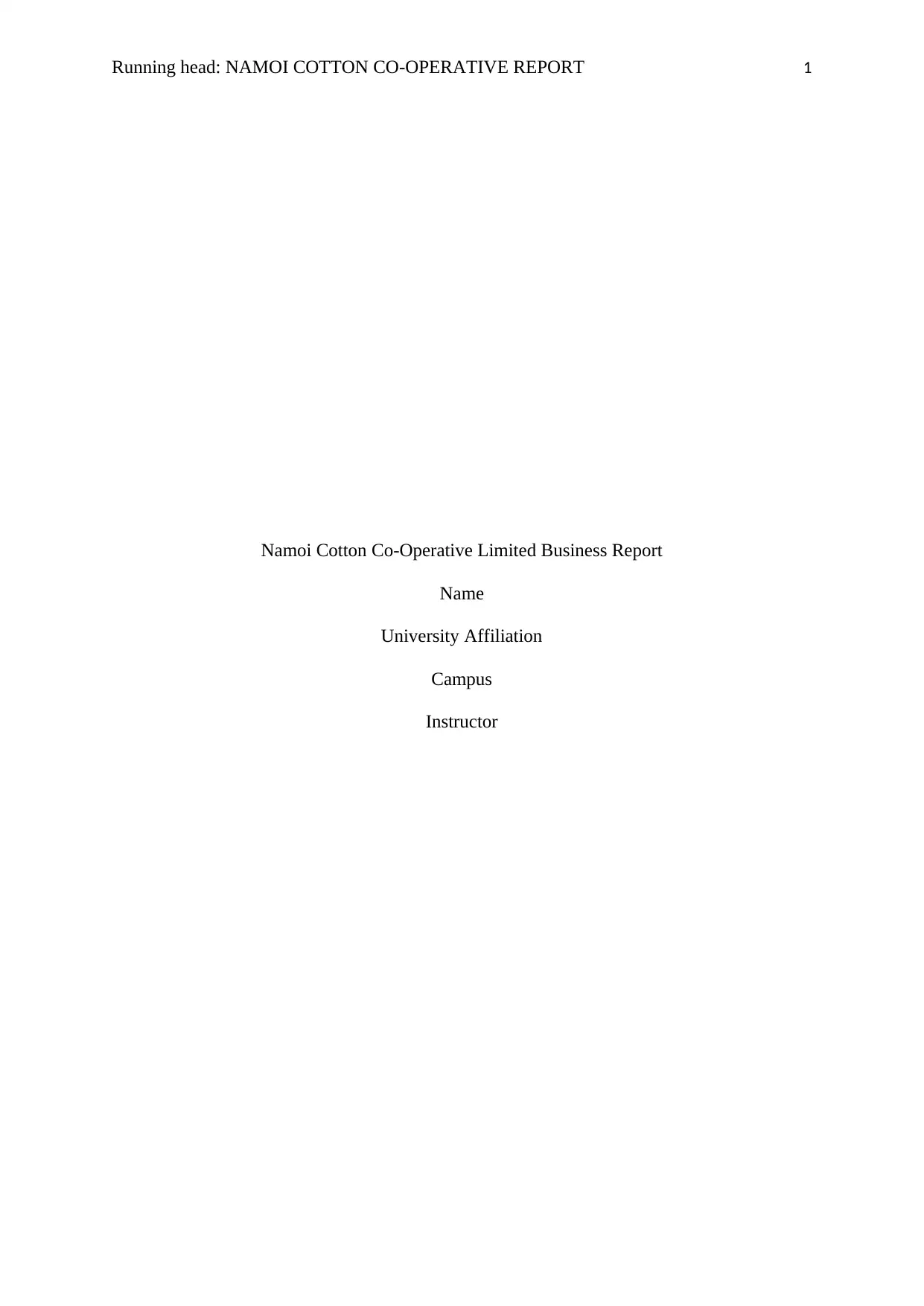
Running head: NAMOI COTTON CO-OPERATIVE REPORT 1
Namoi Cotton Co-Operative Limited Business Report
Name
University Affiliation
Campus
Instructor
Namoi Cotton Co-Operative Limited Business Report
Name
University Affiliation
Campus
Instructor
Secure Best Marks with AI Grader
Need help grading? Try our AI Grader for instant feedback on your assignments.

NAMOI COTTON CO-OPERATIVE BUSINESS REPORT 2
Namoi Cotton Co-Operative Limited Business Report
1. Introduction to the Business and General Business Environment
Analysis of the competitive environment in which a business operates is of great
importance to its present and future performance. First, a business must understand the
competition it faces, the costs it is likely to face as well as the macroeconomic conditions in
the country of operation. The effects of changes in the macroeconomic variables may have
positive or adverse effects on the productivity of the business. Additionally, the social,
environmental and financial practices have a huge impact on the future performance,
sustainability and viability of the business. A critical evaluation of the operations of Namoi
cotton limited company, hereafter referred to as NAM or Namoi Cotton will reveal the effects
of such practises and a prediction of its future performance.
a. Name, Location and Type of Business
Namoi Cotton Co-operative Limited is a publicly listed company in Australia.
Established in 1962, the company has its headquarters in Wee Waa, Australia. It operates in
the agricultural supply chain industry. It serves the rural areas of New South Wales and
Southern Queensland as well as the external market (Namoi Cotton, 2018).
b. The Products
Namoi Co-operative Ltd mainly sells ginning and marketing services. Additionally, it
distributes by-products of ginning like cotton seed, and mote and moss (Aerial Dimensions
Australia,2018). The company works both as a contract ginner and a ginner for the joint
venture, Namoi Cotton Alliance, through which it exports ginned cotton (Namoi
Cotton,2017).
c. The Customers
The main customers of the ginning services offered by NAM are local cotton growers.
A good example of the growers served by the company is Webster (WBA). The NCA also
Namoi Cotton Co-Operative Limited Business Report
1. Introduction to the Business and General Business Environment
Analysis of the competitive environment in which a business operates is of great
importance to its present and future performance. First, a business must understand the
competition it faces, the costs it is likely to face as well as the macroeconomic conditions in
the country of operation. The effects of changes in the macroeconomic variables may have
positive or adverse effects on the productivity of the business. Additionally, the social,
environmental and financial practices have a huge impact on the future performance,
sustainability and viability of the business. A critical evaluation of the operations of Namoi
cotton limited company, hereafter referred to as NAM or Namoi Cotton will reveal the effects
of such practises and a prediction of its future performance.
a. Name, Location and Type of Business
Namoi Cotton Co-operative Limited is a publicly listed company in Australia.
Established in 1962, the company has its headquarters in Wee Waa, Australia. It operates in
the agricultural supply chain industry. It serves the rural areas of New South Wales and
Southern Queensland as well as the external market (Namoi Cotton, 2018).
b. The Products
Namoi Co-operative Ltd mainly sells ginning and marketing services. Additionally, it
distributes by-products of ginning like cotton seed, and mote and moss (Aerial Dimensions
Australia,2018). The company works both as a contract ginner and a ginner for the joint
venture, Namoi Cotton Alliance, through which it exports ginned cotton (Namoi
Cotton,2017).
c. The Customers
The main customers of the ginning services offered by NAM are local cotton growers.
A good example of the growers served by the company is Webster (WBA). The NCA also
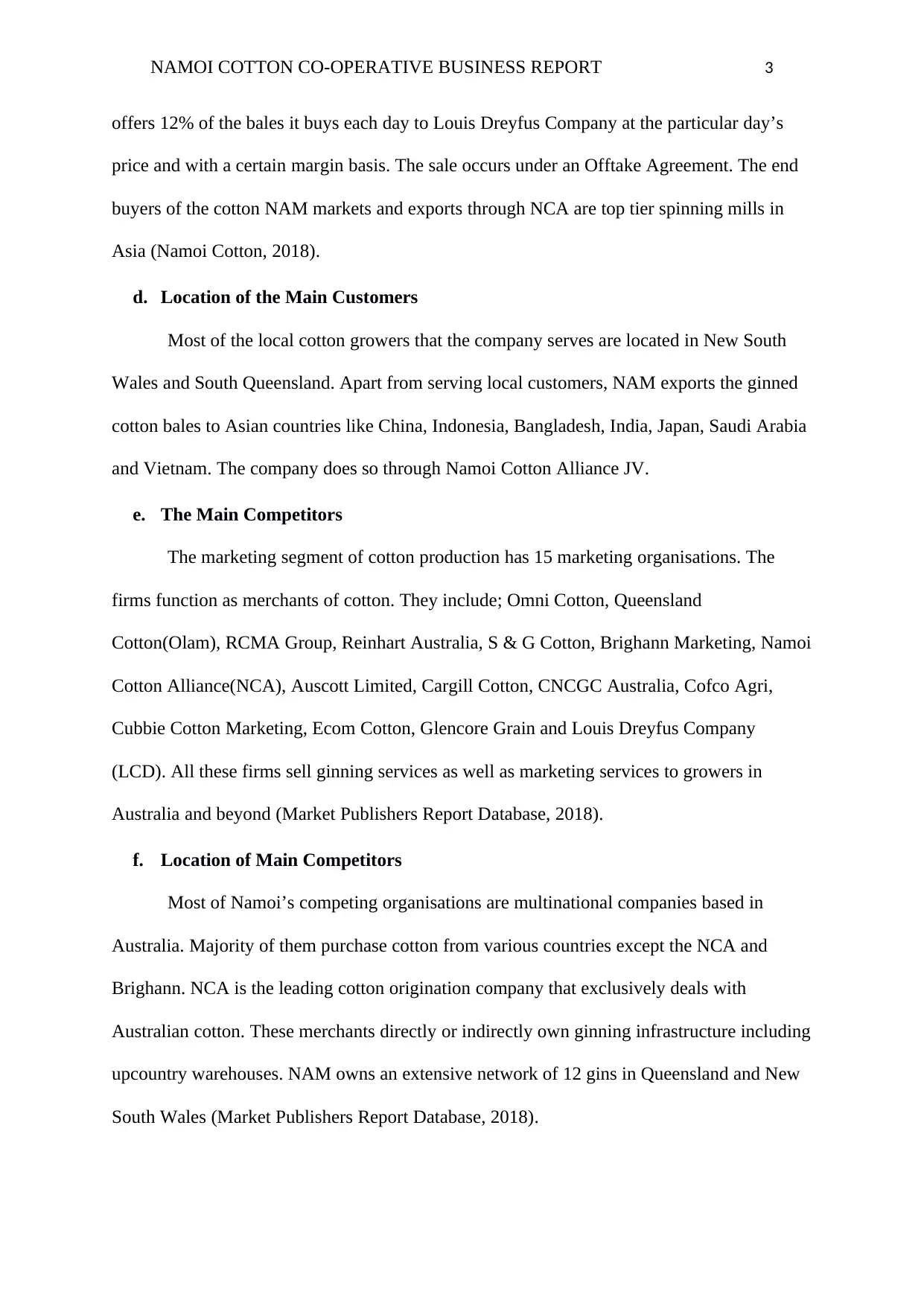
NAMOI COTTON CO-OPERATIVE BUSINESS REPORT 3
offers 12% of the bales it buys each day to Louis Dreyfus Company at the particular day’s
price and with a certain margin basis. The sale occurs under an Offtake Agreement. The end
buyers of the cotton NAM markets and exports through NCA are top tier spinning mills in
Asia (Namoi Cotton, 2018).
d. Location of the Main Customers
Most of the local cotton growers that the company serves are located in New South
Wales and South Queensland. Apart from serving local customers, NAM exports the ginned
cotton bales to Asian countries like China, Indonesia, Bangladesh, India, Japan, Saudi Arabia
and Vietnam. The company does so through Namoi Cotton Alliance JV.
e. The Main Competitors
The marketing segment of cotton production has 15 marketing organisations. The
firms function as merchants of cotton. They include; Omni Cotton, Queensland
Cotton(Olam), RCMA Group, Reinhart Australia, S & G Cotton, Brighann Marketing, Namoi
Cotton Alliance(NCA), Auscott Limited, Cargill Cotton, CNCGC Australia, Cofco Agri,
Cubbie Cotton Marketing, Ecom Cotton, Glencore Grain and Louis Dreyfus Company
(LCD). All these firms sell ginning services as well as marketing services to growers in
Australia and beyond (Market Publishers Report Database, 2018).
f. Location of Main Competitors
Most of Namoi’s competing organisations are multinational companies based in
Australia. Majority of them purchase cotton from various countries except the NCA and
Brighann. NCA is the leading cotton origination company that exclusively deals with
Australian cotton. These merchants directly or indirectly own ginning infrastructure including
upcountry warehouses. NAM owns an extensive network of 12 gins in Queensland and New
South Wales (Market Publishers Report Database, 2018).
offers 12% of the bales it buys each day to Louis Dreyfus Company at the particular day’s
price and with a certain margin basis. The sale occurs under an Offtake Agreement. The end
buyers of the cotton NAM markets and exports through NCA are top tier spinning mills in
Asia (Namoi Cotton, 2018).
d. Location of the Main Customers
Most of the local cotton growers that the company serves are located in New South
Wales and South Queensland. Apart from serving local customers, NAM exports the ginned
cotton bales to Asian countries like China, Indonesia, Bangladesh, India, Japan, Saudi Arabia
and Vietnam. The company does so through Namoi Cotton Alliance JV.
e. The Main Competitors
The marketing segment of cotton production has 15 marketing organisations. The
firms function as merchants of cotton. They include; Omni Cotton, Queensland
Cotton(Olam), RCMA Group, Reinhart Australia, S & G Cotton, Brighann Marketing, Namoi
Cotton Alliance(NCA), Auscott Limited, Cargill Cotton, CNCGC Australia, Cofco Agri,
Cubbie Cotton Marketing, Ecom Cotton, Glencore Grain and Louis Dreyfus Company
(LCD). All these firms sell ginning services as well as marketing services to growers in
Australia and beyond (Market Publishers Report Database, 2018).
f. Location of Main Competitors
Most of Namoi’s competing organisations are multinational companies based in
Australia. Majority of them purchase cotton from various countries except the NCA and
Brighann. NCA is the leading cotton origination company that exclusively deals with
Australian cotton. These merchants directly or indirectly own ginning infrastructure including
upcountry warehouses. NAM owns an extensive network of 12 gins in Queensland and New
South Wales (Market Publishers Report Database, 2018).
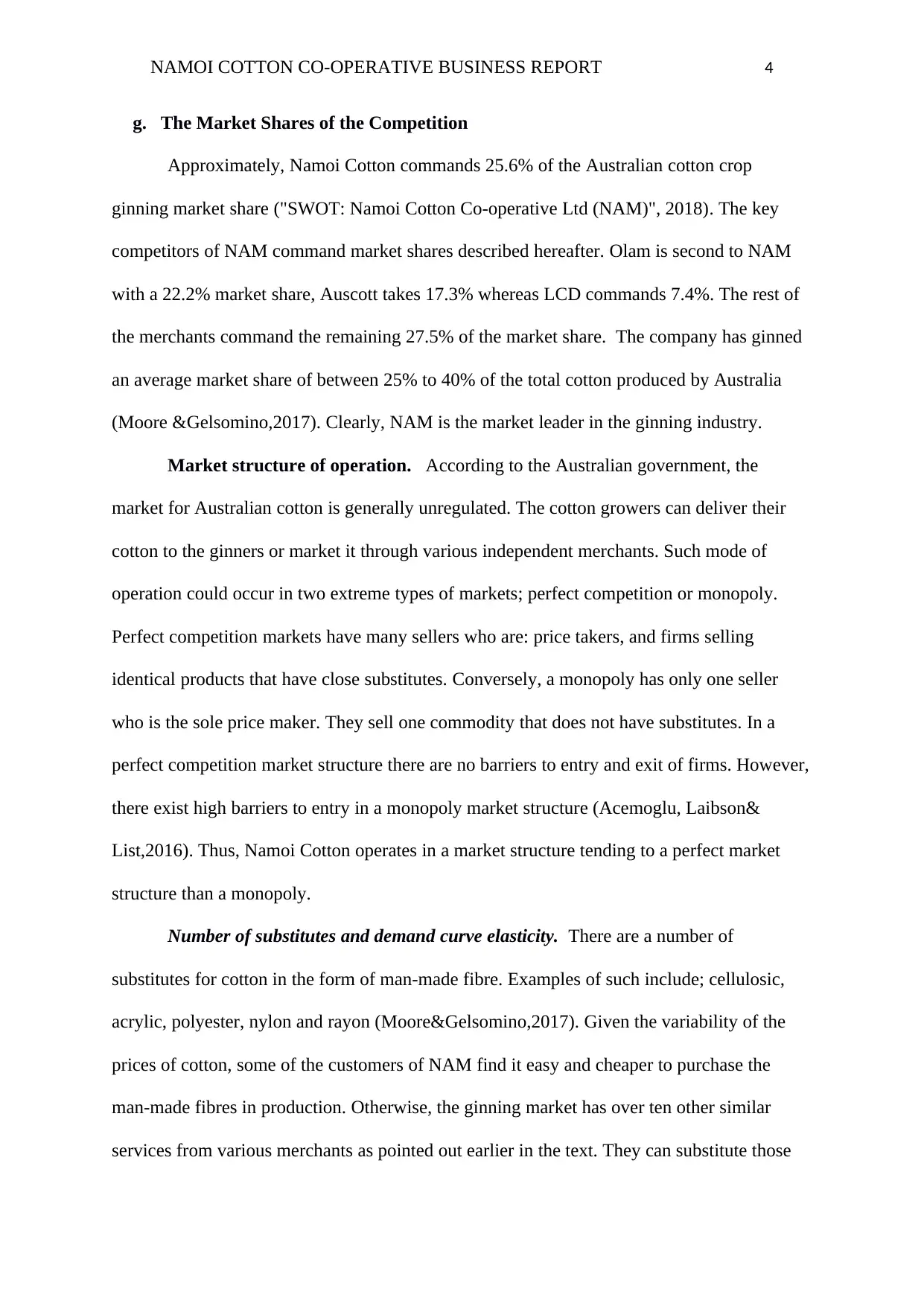
NAMOI COTTON CO-OPERATIVE BUSINESS REPORT 4
g. The Market Shares of the Competition
Approximately, Namoi Cotton commands 25.6% of the Australian cotton crop
ginning market share ("SWOT: Namoi Cotton Co-operative Ltd (NAM)", 2018). The key
competitors of NAM command market shares described hereafter. Olam is second to NAM
with a 22.2% market share, Auscott takes 17.3% whereas LCD commands 7.4%. The rest of
the merchants command the remaining 27.5% of the market share. The company has ginned
an average market share of between 25% to 40% of the total cotton produced by Australia
(Moore &Gelsomino,2017). Clearly, NAM is the market leader in the ginning industry.
Market structure of operation. According to the Australian government, the
market for Australian cotton is generally unregulated. The cotton growers can deliver their
cotton to the ginners or market it through various independent merchants. Such mode of
operation could occur in two extreme types of markets; perfect competition or monopoly.
Perfect competition markets have many sellers who are: price takers, and firms selling
identical products that have close substitutes. Conversely, a monopoly has only one seller
who is the sole price maker. They sell one commodity that does not have substitutes. In a
perfect competition market structure there are no barriers to entry and exit of firms. However,
there exist high barriers to entry in a monopoly market structure (Acemoglu, Laibson&
List,2016). Thus, Namoi Cotton operates in a market structure tending to a perfect market
structure than a monopoly.
Number of substitutes and demand curve elasticity. There are a number of
substitutes for cotton in the form of man-made fibre. Examples of such include; cellulosic,
acrylic, polyester, nylon and rayon (Moore&Gelsomino,2017). Given the variability of the
prices of cotton, some of the customers of NAM find it easy and cheaper to purchase the
man-made fibres in production. Otherwise, the ginning market has over ten other similar
services from various merchants as pointed out earlier in the text. They can substitute those
g. The Market Shares of the Competition
Approximately, Namoi Cotton commands 25.6% of the Australian cotton crop
ginning market share ("SWOT: Namoi Cotton Co-operative Ltd (NAM)", 2018). The key
competitors of NAM command market shares described hereafter. Olam is second to NAM
with a 22.2% market share, Auscott takes 17.3% whereas LCD commands 7.4%. The rest of
the merchants command the remaining 27.5% of the market share. The company has ginned
an average market share of between 25% to 40% of the total cotton produced by Australia
(Moore &Gelsomino,2017). Clearly, NAM is the market leader in the ginning industry.
Market structure of operation. According to the Australian government, the
market for Australian cotton is generally unregulated. The cotton growers can deliver their
cotton to the ginners or market it through various independent merchants. Such mode of
operation could occur in two extreme types of markets; perfect competition or monopoly.
Perfect competition markets have many sellers who are: price takers, and firms selling
identical products that have close substitutes. Conversely, a monopoly has only one seller
who is the sole price maker. They sell one commodity that does not have substitutes. In a
perfect competition market structure there are no barriers to entry and exit of firms. However,
there exist high barriers to entry in a monopoly market structure (Acemoglu, Laibson&
List,2016). Thus, Namoi Cotton operates in a market structure tending to a perfect market
structure than a monopoly.
Number of substitutes and demand curve elasticity. There are a number of
substitutes for cotton in the form of man-made fibre. Examples of such include; cellulosic,
acrylic, polyester, nylon and rayon (Moore&Gelsomino,2017). Given the variability of the
prices of cotton, some of the customers of NAM find it easy and cheaper to purchase the
man-made fibres in production. Otherwise, the ginning market has over ten other similar
services from various merchants as pointed out earlier in the text. They can substitute those
Secure Best Marks with AI Grader
Need help grading? Try our AI Grader for instant feedback on your assignments.
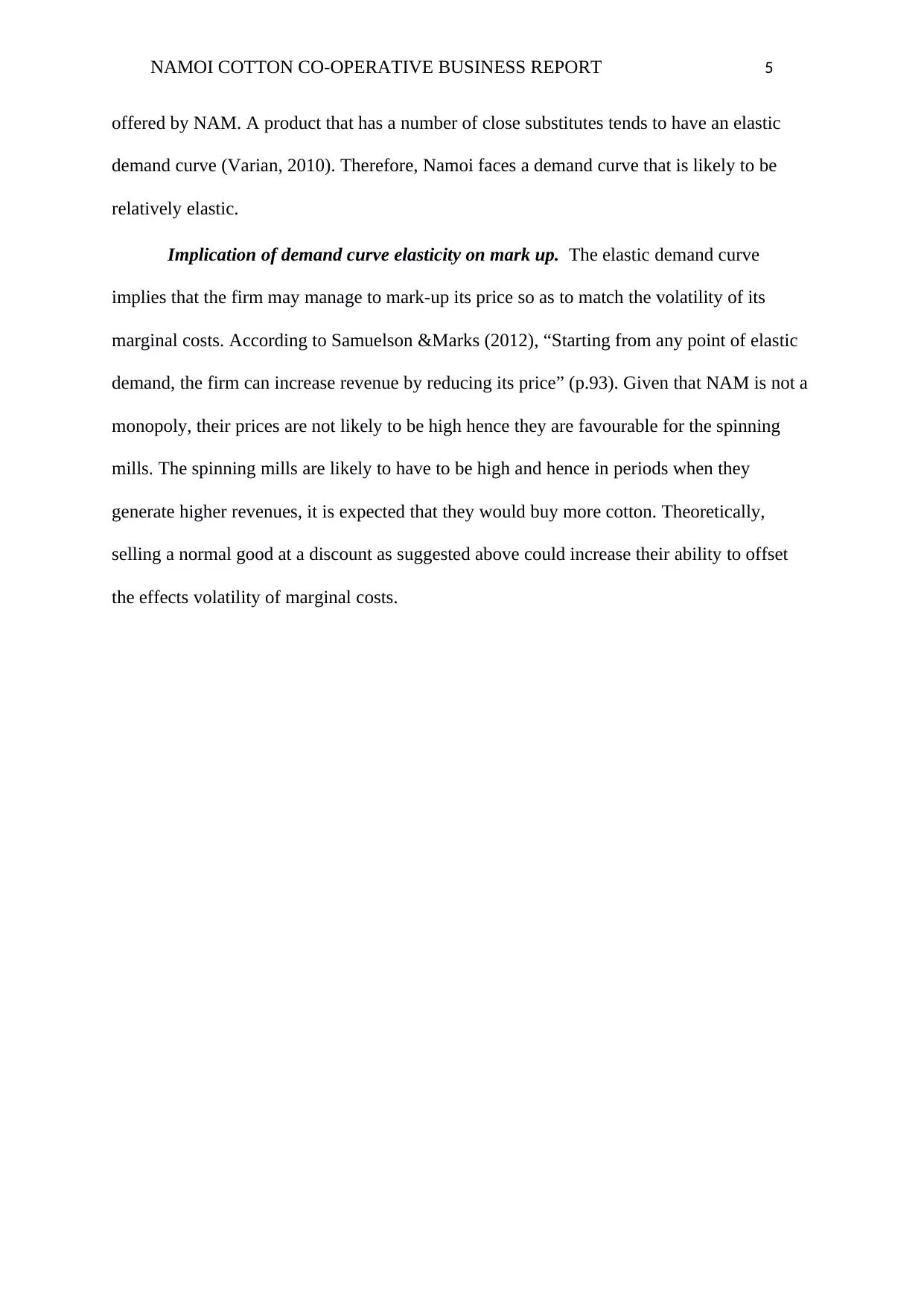
NAMOI COTTON CO-OPERATIVE BUSINESS REPORT 5
offered by NAM. A product that has a number of close substitutes tends to have an elastic
demand curve (Varian, 2010). Therefore, Namoi faces a demand curve that is likely to be
relatively elastic.
Implication of demand curve elasticity on mark up. The elastic demand curve
implies that the firm may manage to mark-up its price so as to match the volatility of its
marginal costs. According to Samuelson &Marks (2012), “Starting from any point of elastic
demand, the firm can increase revenue by reducing its price” (p.93). Given that NAM is not a
monopoly, their prices are not likely to be high hence they are favourable for the spinning
mills. The spinning mills are likely to have to be high and hence in periods when they
generate higher revenues, it is expected that they would buy more cotton. Theoretically,
selling a normal good at a discount as suggested above could increase their ability to offset
the effects volatility of marginal costs.
offered by NAM. A product that has a number of close substitutes tends to have an elastic
demand curve (Varian, 2010). Therefore, Namoi faces a demand curve that is likely to be
relatively elastic.
Implication of demand curve elasticity on mark up. The elastic demand curve
implies that the firm may manage to mark-up its price so as to match the volatility of its
marginal costs. According to Samuelson &Marks (2012), “Starting from any point of elastic
demand, the firm can increase revenue by reducing its price” (p.93). Given that NAM is not a
monopoly, their prices are not likely to be high hence they are favourable for the spinning
mills. The spinning mills are likely to have to be high and hence in periods when they
generate higher revenues, it is expected that they would buy more cotton. Theoretically,
selling a normal good at a discount as suggested above could increase their ability to offset
the effects volatility of marginal costs.
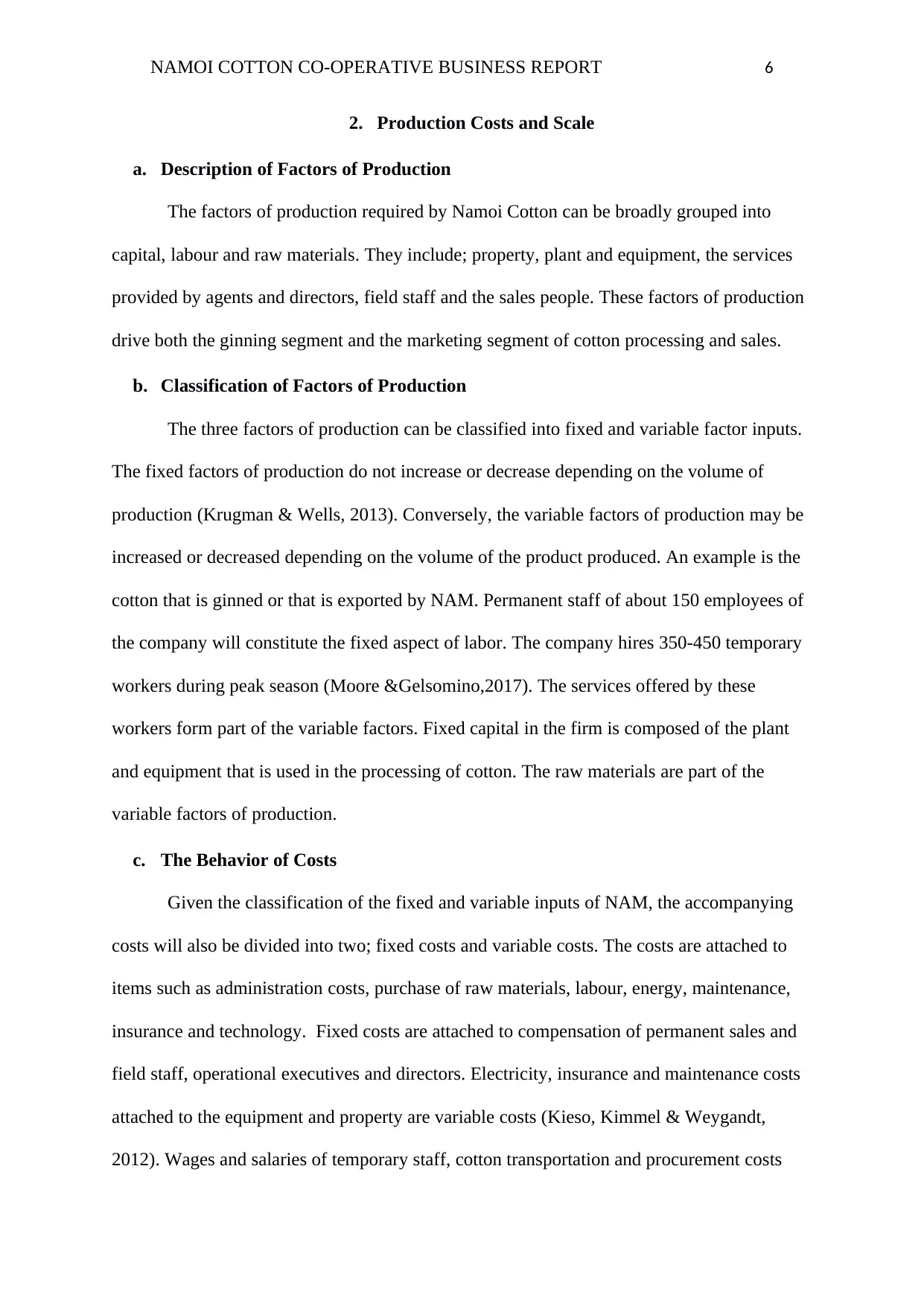
NAMOI COTTON CO-OPERATIVE BUSINESS REPORT 6
2. Production Costs and Scale
a. Description of Factors of Production
The factors of production required by Namoi Cotton can be broadly grouped into
capital, labour and raw materials. They include; property, plant and equipment, the services
provided by agents and directors, field staff and the sales people. These factors of production
drive both the ginning segment and the marketing segment of cotton processing and sales.
b. Classification of Factors of Production
The three factors of production can be classified into fixed and variable factor inputs.
The fixed factors of production do not increase or decrease depending on the volume of
production (Krugman & Wells, 2013). Conversely, the variable factors of production may be
increased or decreased depending on the volume of the product produced. An example is the
cotton that is ginned or that is exported by NAM. Permanent staff of about 150 employees of
the company will constitute the fixed aspect of labor. The company hires 350-450 temporary
workers during peak season (Moore &Gelsomino,2017). The services offered by these
workers form part of the variable factors. Fixed capital in the firm is composed of the plant
and equipment that is used in the processing of cotton. The raw materials are part of the
variable factors of production.
c. The Behavior of Costs
Given the classification of the fixed and variable inputs of NAM, the accompanying
costs will also be divided into two; fixed costs and variable costs. The costs are attached to
items such as administration costs, purchase of raw materials, labour, energy, maintenance,
insurance and technology. Fixed costs are attached to compensation of permanent sales and
field staff, operational executives and directors. Electricity, insurance and maintenance costs
attached to the equipment and property are variable costs (Kieso, Kimmel & Weygandt,
2012). Wages and salaries of temporary staff, cotton transportation and procurement costs
2. Production Costs and Scale
a. Description of Factors of Production
The factors of production required by Namoi Cotton can be broadly grouped into
capital, labour and raw materials. They include; property, plant and equipment, the services
provided by agents and directors, field staff and the sales people. These factors of production
drive both the ginning segment and the marketing segment of cotton processing and sales.
b. Classification of Factors of Production
The three factors of production can be classified into fixed and variable factor inputs.
The fixed factors of production do not increase or decrease depending on the volume of
production (Krugman & Wells, 2013). Conversely, the variable factors of production may be
increased or decreased depending on the volume of the product produced. An example is the
cotton that is ginned or that is exported by NAM. Permanent staff of about 150 employees of
the company will constitute the fixed aspect of labor. The company hires 350-450 temporary
workers during peak season (Moore &Gelsomino,2017). The services offered by these
workers form part of the variable factors. Fixed capital in the firm is composed of the plant
and equipment that is used in the processing of cotton. The raw materials are part of the
variable factors of production.
c. The Behavior of Costs
Given the classification of the fixed and variable inputs of NAM, the accompanying
costs will also be divided into two; fixed costs and variable costs. The costs are attached to
items such as administration costs, purchase of raw materials, labour, energy, maintenance,
insurance and technology. Fixed costs are attached to compensation of permanent sales and
field staff, operational executives and directors. Electricity, insurance and maintenance costs
attached to the equipment and property are variable costs (Kieso, Kimmel & Weygandt,
2012). Wages and salaries of temporary staff, cotton transportation and procurement costs

NAMOI COTTON CO-OPERATIVE BUSINESS REPORT 7
variable costs. Unlike the fixed costs, variable costs increase with the increase in volume of
cotton bales acquired for ginning and those that are prepared for export.
Cost structure and scale. The likely cost structure for this company is a cost-
driven cost structure. It involves cost items such as raw materials, processing(ginning),
storage, transportation, marketing and sales. It is a mixed structure that has a low
proportion of fixed costs relative to the variable costs aiming at minimising costs. The firm
is likely to be large given that it has a higher proportion of variable costs compared to
fixed costs. A large firm will choose to operate on lower average costs (Layton, Robinson
& Tucker, 2015). The total fixed costs that NAM faces are low. Therefore, the company is
operating on a large scale and its optimal size is likely to be large.
variable costs. Unlike the fixed costs, variable costs increase with the increase in volume of
cotton bales acquired for ginning and those that are prepared for export.
Cost structure and scale. The likely cost structure for this company is a cost-
driven cost structure. It involves cost items such as raw materials, processing(ginning),
storage, transportation, marketing and sales. It is a mixed structure that has a low
proportion of fixed costs relative to the variable costs aiming at minimising costs. The firm
is likely to be large given that it has a higher proportion of variable costs compared to
fixed costs. A large firm will choose to operate on lower average costs (Layton, Robinson
& Tucker, 2015). The total fixed costs that NAM faces are low. Therefore, the company is
operating on a large scale and its optimal size is likely to be large.
Paraphrase This Document
Need a fresh take? Get an instant paraphrase of this document with our AI Paraphraser
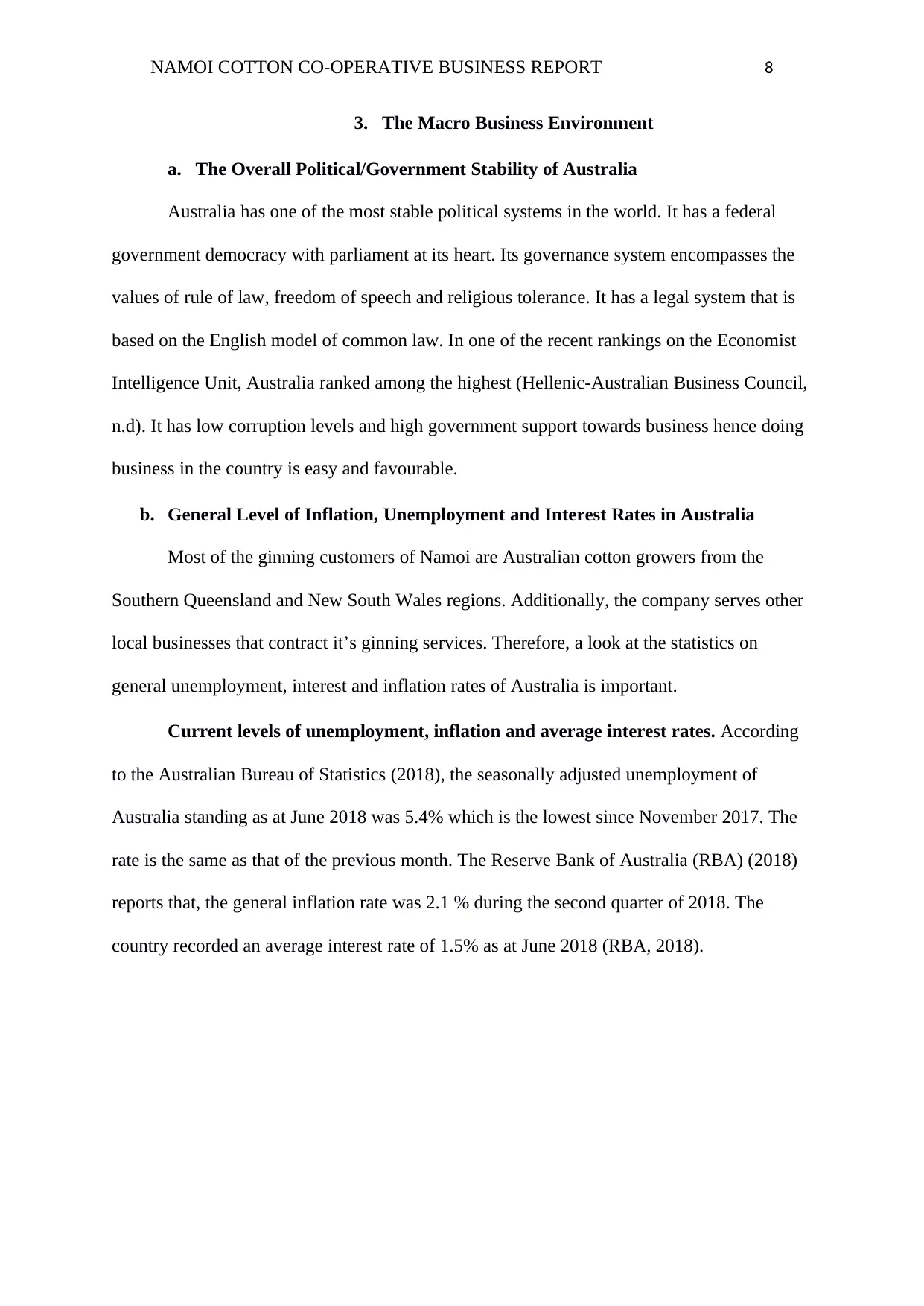
NAMOI COTTON CO-OPERATIVE BUSINESS REPORT 8
3. The Macro Business Environment
a. The Overall Political/Government Stability of Australia
Australia has one of the most stable political systems in the world. It has a federal
government democracy with parliament at its heart. Its governance system encompasses the
values of rule of law, freedom of speech and religious tolerance. It has a legal system that is
based on the English model of common law. In one of the recent rankings on the Economist
Intelligence Unit, Australia ranked among the highest (Hellenic-Australian Business Council,
n.d). It has low corruption levels and high government support towards business hence doing
business in the country is easy and favourable.
b. General Level of Inflation, Unemployment and Interest Rates in Australia
Most of the ginning customers of Namoi are Australian cotton growers from the
Southern Queensland and New South Wales regions. Additionally, the company serves other
local businesses that contract it’s ginning services. Therefore, a look at the statistics on
general unemployment, interest and inflation rates of Australia is important.
Current levels of unemployment, inflation and average interest rates. According
to the Australian Bureau of Statistics (2018), the seasonally adjusted unemployment of
Australia standing as at June 2018 was 5.4% which is the lowest since November 2017. The
rate is the same as that of the previous month. The Reserve Bank of Australia (RBA) (2018)
reports that, the general inflation rate was 2.1 % during the second quarter of 2018. The
country recorded an average interest rate of 1.5% as at June 2018 (RBA, 2018).
3. The Macro Business Environment
a. The Overall Political/Government Stability of Australia
Australia has one of the most stable political systems in the world. It has a federal
government democracy with parliament at its heart. Its governance system encompasses the
values of rule of law, freedom of speech and religious tolerance. It has a legal system that is
based on the English model of common law. In one of the recent rankings on the Economist
Intelligence Unit, Australia ranked among the highest (Hellenic-Australian Business Council,
n.d). It has low corruption levels and high government support towards business hence doing
business in the country is easy and favourable.
b. General Level of Inflation, Unemployment and Interest Rates in Australia
Most of the ginning customers of Namoi are Australian cotton growers from the
Southern Queensland and New South Wales regions. Additionally, the company serves other
local businesses that contract it’s ginning services. Therefore, a look at the statistics on
general unemployment, interest and inflation rates of Australia is important.
Current levels of unemployment, inflation and average interest rates. According
to the Australian Bureau of Statistics (2018), the seasonally adjusted unemployment of
Australia standing as at June 2018 was 5.4% which is the lowest since November 2017. The
rate is the same as that of the previous month. The Reserve Bank of Australia (RBA) (2018)
reports that, the general inflation rate was 2.1 % during the second quarter of 2018. The
country recorded an average interest rate of 1.5% as at June 2018 (RBA, 2018).
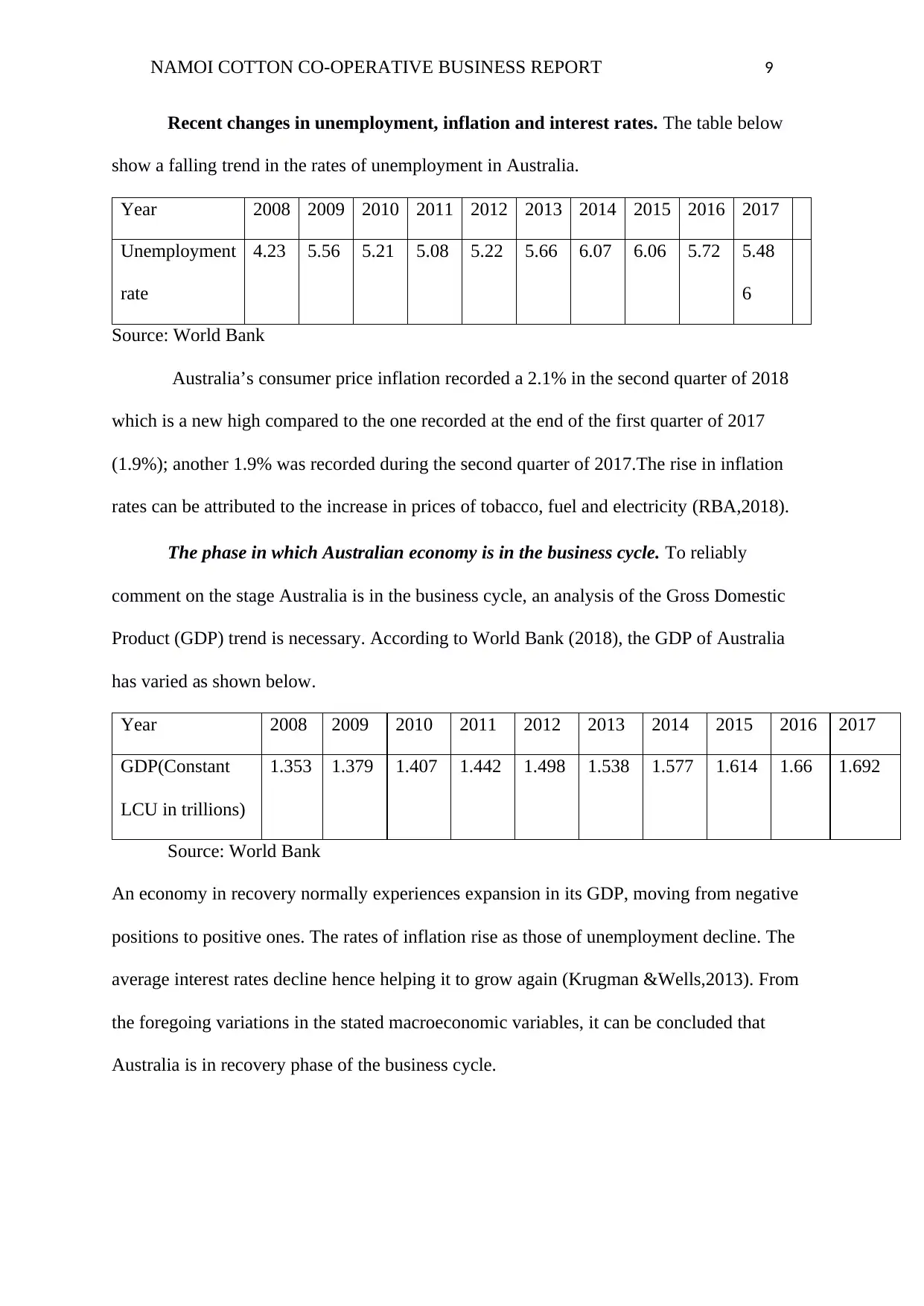
NAMOI COTTON CO-OPERATIVE BUSINESS REPORT 9
Recent changes in unemployment, inflation and interest rates. The table below
show a falling trend in the rates of unemployment in Australia.
Year 2008 2009 2010 2011 2012 2013 2014 2015 2016 2017
Unemployment
rate
4.23 5.56 5.21 5.08 5.22 5.66 6.07 6.06 5.72 5.48
6
Source: World Bank
Australia’s consumer price inflation recorded a 2.1% in the second quarter of 2018
which is a new high compared to the one recorded at the end of the first quarter of 2017
(1.9%); another 1.9% was recorded during the second quarter of 2017.The rise in inflation
rates can be attributed to the increase in prices of tobacco, fuel and electricity (RBA,2018).
The phase in which Australian economy is in the business cycle. To reliably
comment on the stage Australia is in the business cycle, an analysis of the Gross Domestic
Product (GDP) trend is necessary. According to World Bank (2018), the GDP of Australia
has varied as shown below.
Year 2008 2009 2010 2011 2012 2013 2014 2015 2016 2017
GDP(Constant
LCU in trillions)
1.353 1.379 1.407 1.442 1.498 1.538 1.577 1.614 1.66 1.692
Source: World Bank
An economy in recovery normally experiences expansion in its GDP, moving from negative
positions to positive ones. The rates of inflation rise as those of unemployment decline. The
average interest rates decline hence helping it to grow again (Krugman &Wells,2013). From
the foregoing variations in the stated macroeconomic variables, it can be concluded that
Australia is in recovery phase of the business cycle.
Recent changes in unemployment, inflation and interest rates. The table below
show a falling trend in the rates of unemployment in Australia.
Year 2008 2009 2010 2011 2012 2013 2014 2015 2016 2017
Unemployment
rate
4.23 5.56 5.21 5.08 5.22 5.66 6.07 6.06 5.72 5.48
6
Source: World Bank
Australia’s consumer price inflation recorded a 2.1% in the second quarter of 2018
which is a new high compared to the one recorded at the end of the first quarter of 2017
(1.9%); another 1.9% was recorded during the second quarter of 2017.The rise in inflation
rates can be attributed to the increase in prices of tobacco, fuel and electricity (RBA,2018).
The phase in which Australian economy is in the business cycle. To reliably
comment on the stage Australia is in the business cycle, an analysis of the Gross Domestic
Product (GDP) trend is necessary. According to World Bank (2018), the GDP of Australia
has varied as shown below.
Year 2008 2009 2010 2011 2012 2013 2014 2015 2016 2017
GDP(Constant
LCU in trillions)
1.353 1.379 1.407 1.442 1.498 1.538 1.577 1.614 1.66 1.692
Source: World Bank
An economy in recovery normally experiences expansion in its GDP, moving from negative
positions to positive ones. The rates of inflation rise as those of unemployment decline. The
average interest rates decline hence helping it to grow again (Krugman &Wells,2013). From
the foregoing variations in the stated macroeconomic variables, it can be concluded that
Australia is in recovery phase of the business cycle.
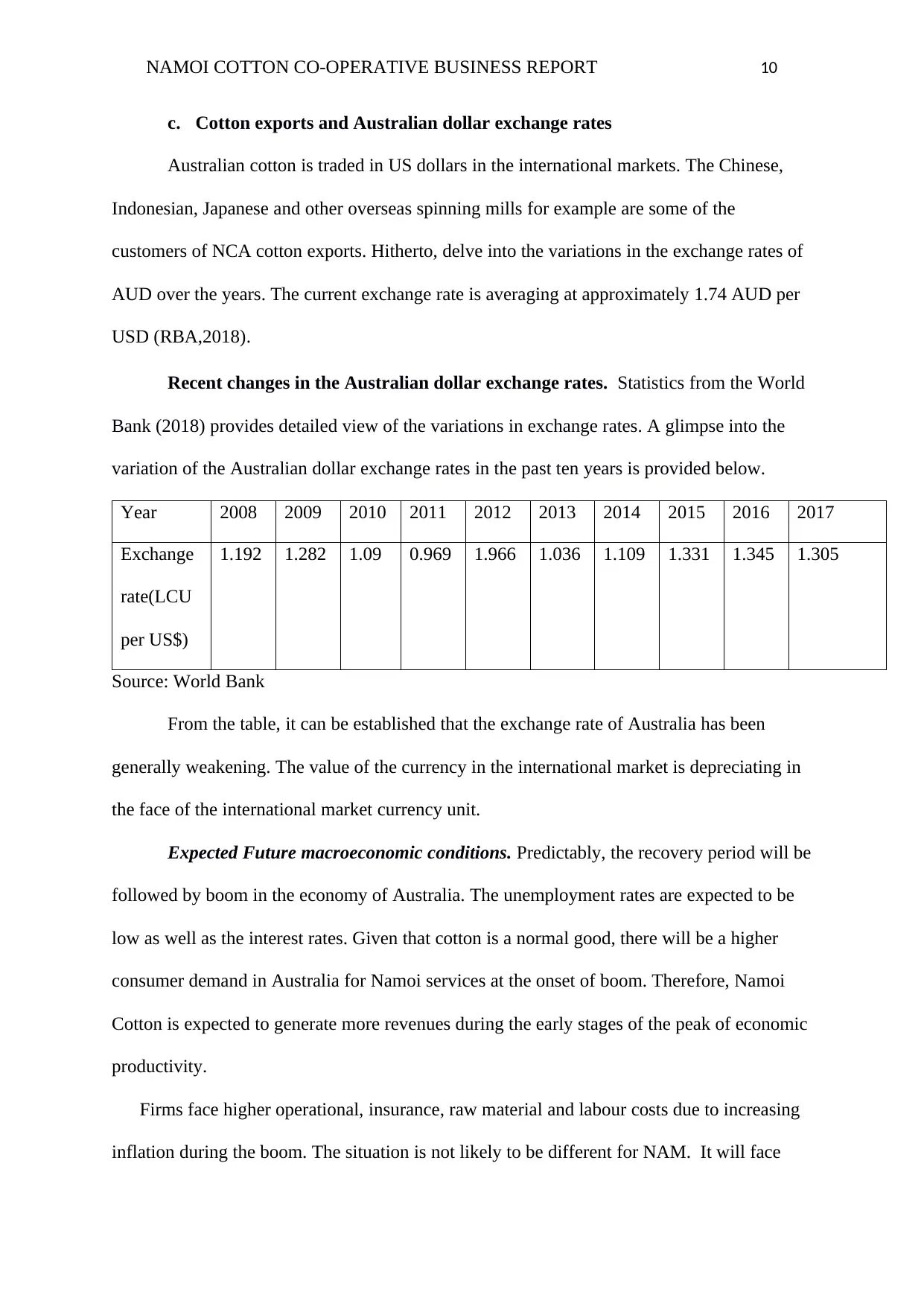
NAMOI COTTON CO-OPERATIVE BUSINESS REPORT 10
c. Cotton exports and Australian dollar exchange rates
Australian cotton is traded in US dollars in the international markets. The Chinese,
Indonesian, Japanese and other overseas spinning mills for example are some of the
customers of NCA cotton exports. Hitherto, delve into the variations in the exchange rates of
AUD over the years. The current exchange rate is averaging at approximately 1.74 AUD per
USD (RBA,2018).
Recent changes in the Australian dollar exchange rates. Statistics from the World
Bank (2018) provides detailed view of the variations in exchange rates. A glimpse into the
variation of the Australian dollar exchange rates in the past ten years is provided below.
Year 2008 2009 2010 2011 2012 2013 2014 2015 2016 2017
Exchange
rate(LCU
per US$)
1.192 1.282 1.09 0.969 1.966 1.036 1.109 1.331 1.345 1.305
Source: World Bank
From the table, it can be established that the exchange rate of Australia has been
generally weakening. The value of the currency in the international market is depreciating in
the face of the international market currency unit.
Expected Future macroeconomic conditions. Predictably, the recovery period will be
followed by boom in the economy of Australia. The unemployment rates are expected to be
low as well as the interest rates. Given that cotton is a normal good, there will be a higher
consumer demand in Australia for Namoi services at the onset of boom. Therefore, Namoi
Cotton is expected to generate more revenues during the early stages of the peak of economic
productivity.
Firms face higher operational, insurance, raw material and labour costs due to increasing
inflation during the boom. The situation is not likely to be different for NAM. It will face
c. Cotton exports and Australian dollar exchange rates
Australian cotton is traded in US dollars in the international markets. The Chinese,
Indonesian, Japanese and other overseas spinning mills for example are some of the
customers of NCA cotton exports. Hitherto, delve into the variations in the exchange rates of
AUD over the years. The current exchange rate is averaging at approximately 1.74 AUD per
USD (RBA,2018).
Recent changes in the Australian dollar exchange rates. Statistics from the World
Bank (2018) provides detailed view of the variations in exchange rates. A glimpse into the
variation of the Australian dollar exchange rates in the past ten years is provided below.
Year 2008 2009 2010 2011 2012 2013 2014 2015 2016 2017
Exchange
rate(LCU
per US$)
1.192 1.282 1.09 0.969 1.966 1.036 1.109 1.331 1.345 1.305
Source: World Bank
From the table, it can be established that the exchange rate of Australia has been
generally weakening. The value of the currency in the international market is depreciating in
the face of the international market currency unit.
Expected Future macroeconomic conditions. Predictably, the recovery period will be
followed by boom in the economy of Australia. The unemployment rates are expected to be
low as well as the interest rates. Given that cotton is a normal good, there will be a higher
consumer demand in Australia for Namoi services at the onset of boom. Therefore, Namoi
Cotton is expected to generate more revenues during the early stages of the peak of economic
productivity.
Firms face higher operational, insurance, raw material and labour costs due to increasing
inflation during the boom. The situation is not likely to be different for NAM. It will face
Secure Best Marks with AI Grader
Need help grading? Try our AI Grader for instant feedback on your assignments.
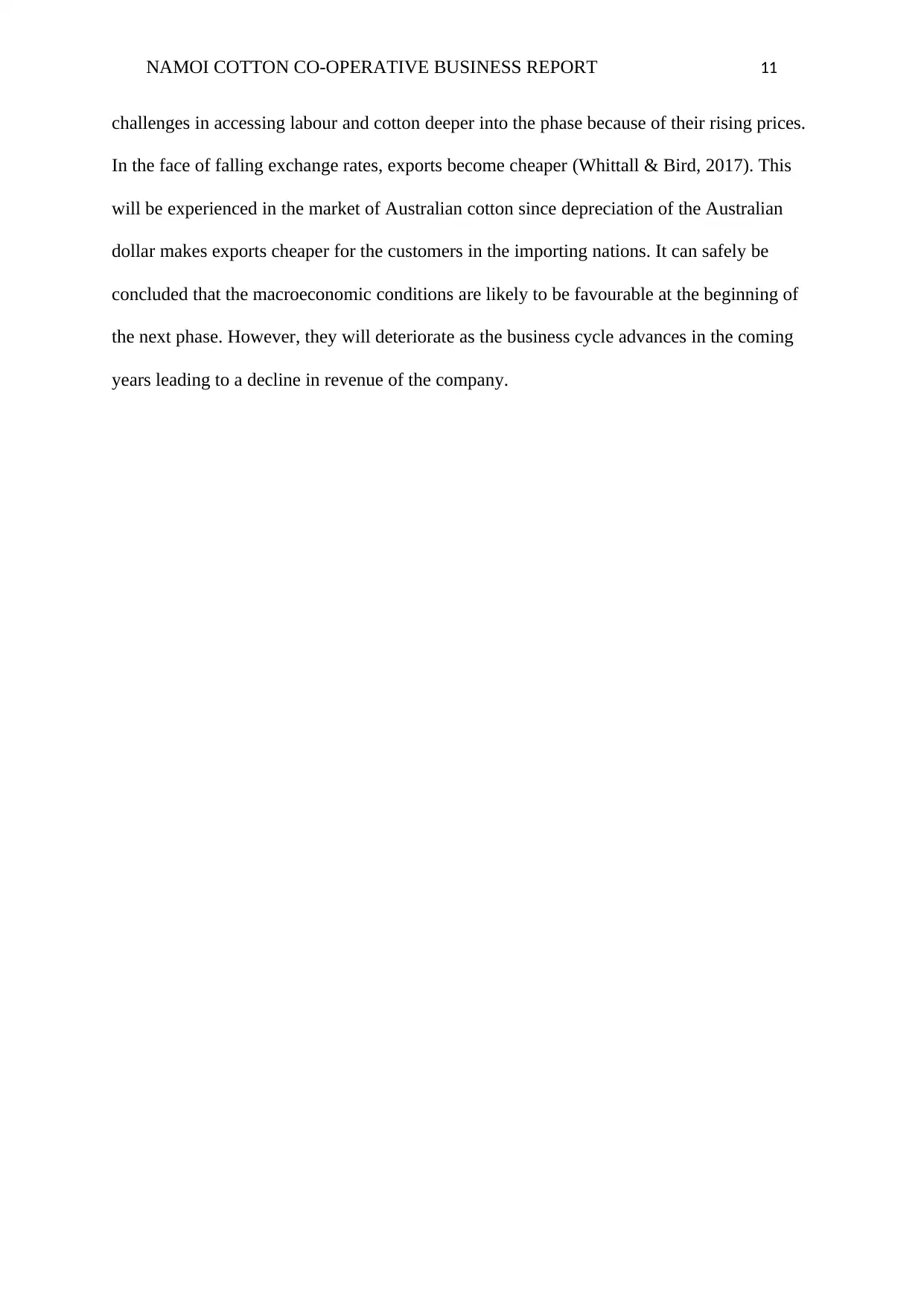
NAMOI COTTON CO-OPERATIVE BUSINESS REPORT 11
challenges in accessing labour and cotton deeper into the phase because of their rising prices.
In the face of falling exchange rates, exports become cheaper (Whittall & Bird, 2017). This
will be experienced in the market of Australian cotton since depreciation of the Australian
dollar makes exports cheaper for the customers in the importing nations. It can safely be
concluded that the macroeconomic conditions are likely to be favourable at the beginning of
the next phase. However, they will deteriorate as the business cycle advances in the coming
years leading to a decline in revenue of the company.
challenges in accessing labour and cotton deeper into the phase because of their rising prices.
In the face of falling exchange rates, exports become cheaper (Whittall & Bird, 2017). This
will be experienced in the market of Australian cotton since depreciation of the Australian
dollar makes exports cheaper for the customers in the importing nations. It can safely be
concluded that the macroeconomic conditions are likely to be favourable at the beginning of
the next phase. However, they will deteriorate as the business cycle advances in the coming
years leading to a decline in revenue of the company.

NAMOI COTTON CO-OPERATIVE BUSINESS REPORT 12
4. Sustainability practice of the business
a. Production externalities
Production activities can affect third parties in a bucolic nature or by benefiting them.
However, these effects do not appear in market transactions(Nicholson&Snyder,2008). Here
below is a description for the case of Namoi cotton.
Negative externalities. The negative externalities due to the production of the
services of Namoi include the risks associated with noise, spills at the gins as well as noise
and air pollution. Occurrence of such risks could lead to societal problems for residents of the
regions surrounding the gins.
Company internalization policies. The producer has to put measures in place to
ensure that they can internalize the cost of offsetting the negative effects of their production
activities. Namoi Cotton manages the water runoff, possible dust emissions and noise do not
affect the welfare of the community. Namoi Cotton (n.d.) describes an environmental
monitoring program that involves all its 12 ginning sites that performs regular environmental
audits. The results are reported on their website. Further, the company has established
pollution incident management plans to ensure that any pollution incident is reported fast and
procedurally at all ginning sites.
4. Sustainability practice of the business
a. Production externalities
Production activities can affect third parties in a bucolic nature or by benefiting them.
However, these effects do not appear in market transactions(Nicholson&Snyder,2008). Here
below is a description for the case of Namoi cotton.
Negative externalities. The negative externalities due to the production of the
services of Namoi include the risks associated with noise, spills at the gins as well as noise
and air pollution. Occurrence of such risks could lead to societal problems for residents of the
regions surrounding the gins.
Company internalization policies. The producer has to put measures in place to
ensure that they can internalize the cost of offsetting the negative effects of their production
activities. Namoi Cotton manages the water runoff, possible dust emissions and noise do not
affect the welfare of the community. Namoi Cotton (n.d.) describes an environmental
monitoring program that involves all its 12 ginning sites that performs regular environmental
audits. The results are reported on their website. Further, the company has established
pollution incident management plans to ensure that any pollution incident is reported fast and
procedurally at all ginning sites.

NAMOI COTTON CO-OPERATIVE BUSINESS REPORT 13
Government policies. The government has established laws that protect the
communities around plant and production sites from pollution(Gifford,2013). For example,
under Protection of the Environment Operations Act 1997(NSW), the government directs that
all the warehousing and ginning facilities in New South Wales are licenced. Namoi Cotton
(n.d.) indicates that all NAM gins are licenced according to the requirement of the
Environment Protection Agency (EPA). The penalties for failure to comply include AUD $
5million for ‘Tier 1’ offenses, AUD $ 1 million for ‘Tier 2’ offenses. ‘Tier 3’ penalties are
subject to fees and penalty notices (Preston,2011). These penalties are there to discourage the
occurrence of the negative externalities.
Positive externalities. There are a number of benefits to third parties that can be
attributed to the Namoi Cotton. Firstly, the ginning services of the company have led
community support projects over the past 50 years. The projects include contribution to the
Westpac Rescue Helicopter Service, Wee Waa Public and Private Schools, Cancer Council of
Australia and the District Sporting clubs. Secondly, the company supports the cotton industry
by representing the crop at the Cotton Australia, Moree Trade Show, Water Users Group,
Australian Cotton conference, Australian Cotton Ginners Association and other bodies or
events (Namoi Cotton, n.d.).
Company positive externality encouragement. In response to the occurrence of this
externality, the company has devised ways to take advantage of the positive. It regularly
encourages its workers to engage charity events and also to contribute to such events at local,
state and national levels. To reinforce it, the company holds an annual golf day as its charity
event at every year at its headquarters in Wee Waa. All the money collected during the event
is distributed to local communities (Namoi Cotton, n.d.).
Government policies. The government has established laws that protect the
communities around plant and production sites from pollution(Gifford,2013). For example,
under Protection of the Environment Operations Act 1997(NSW), the government directs that
all the warehousing and ginning facilities in New South Wales are licenced. Namoi Cotton
(n.d.) indicates that all NAM gins are licenced according to the requirement of the
Environment Protection Agency (EPA). The penalties for failure to comply include AUD $
5million for ‘Tier 1’ offenses, AUD $ 1 million for ‘Tier 2’ offenses. ‘Tier 3’ penalties are
subject to fees and penalty notices (Preston,2011). These penalties are there to discourage the
occurrence of the negative externalities.
Positive externalities. There are a number of benefits to third parties that can be
attributed to the Namoi Cotton. Firstly, the ginning services of the company have led
community support projects over the past 50 years. The projects include contribution to the
Westpac Rescue Helicopter Service, Wee Waa Public and Private Schools, Cancer Council of
Australia and the District Sporting clubs. Secondly, the company supports the cotton industry
by representing the crop at the Cotton Australia, Moree Trade Show, Water Users Group,
Australian Cotton conference, Australian Cotton Ginners Association and other bodies or
events (Namoi Cotton, n.d.).
Company positive externality encouragement. In response to the occurrence of this
externality, the company has devised ways to take advantage of the positive. It regularly
encourages its workers to engage charity events and also to contribute to such events at local,
state and national levels. To reinforce it, the company holds an annual golf day as its charity
event at every year at its headquarters in Wee Waa. All the money collected during the event
is distributed to local communities (Namoi Cotton, n.d.).
Paraphrase This Document
Need a fresh take? Get an instant paraphrase of this document with our AI Paraphraser
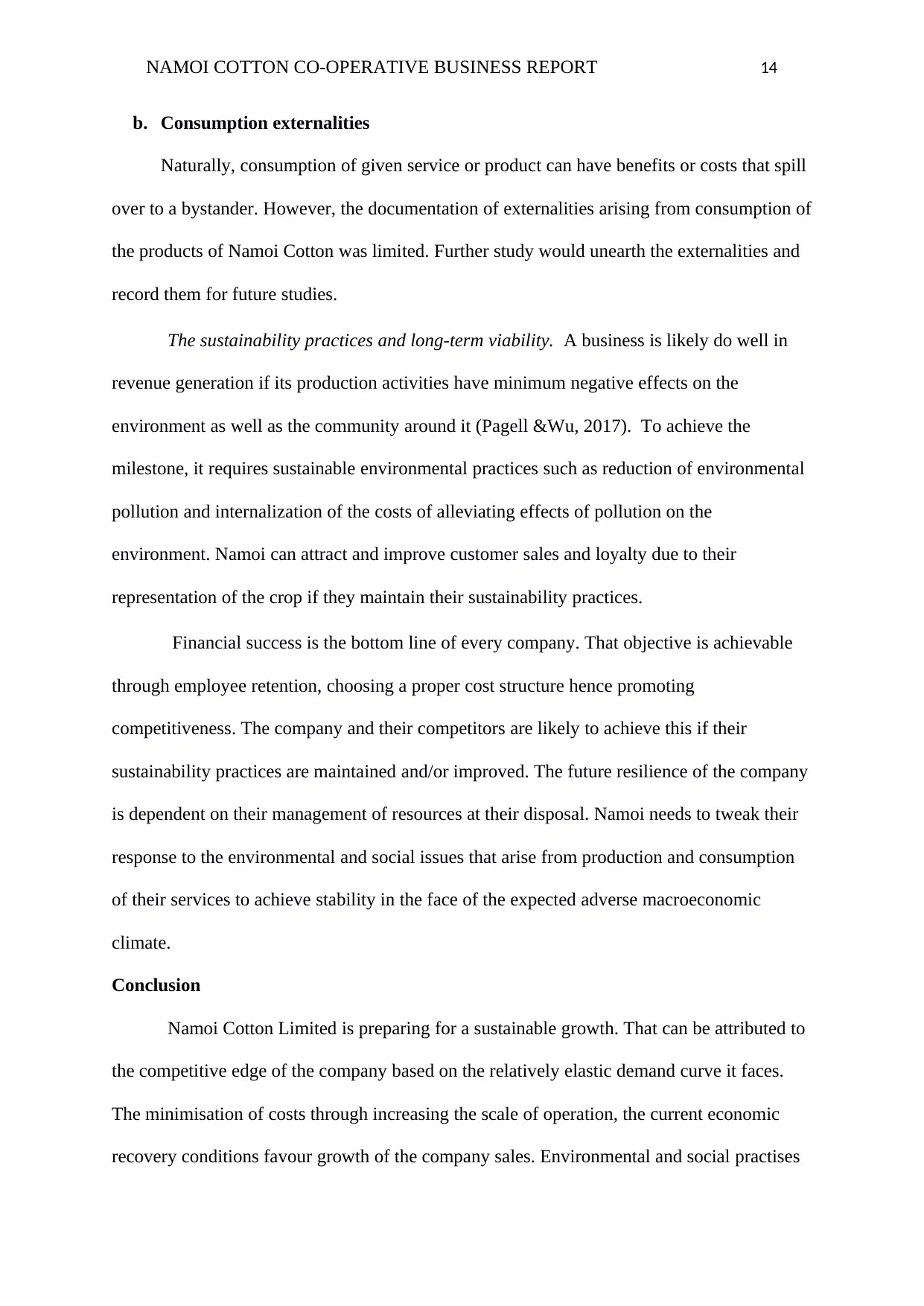
NAMOI COTTON CO-OPERATIVE BUSINESS REPORT 14
b. Consumption externalities
Naturally, consumption of given service or product can have benefits or costs that spill
over to a bystander. However, the documentation of externalities arising from consumption of
the products of Namoi Cotton was limited. Further study would unearth the externalities and
record them for future studies.
The sustainability practices and long-term viability. A business is likely do well in
revenue generation if its production activities have minimum negative effects on the
environment as well as the community around it (Pagell &Wu, 2017). To achieve the
milestone, it requires sustainable environmental practices such as reduction of environmental
pollution and internalization of the costs of alleviating effects of pollution on the
environment. Namoi can attract and improve customer sales and loyalty due to their
representation of the crop if they maintain their sustainability practices.
Financial success is the bottom line of every company. That objective is achievable
through employee retention, choosing a proper cost structure hence promoting
competitiveness. The company and their competitors are likely to achieve this if their
sustainability practices are maintained and/or improved. The future resilience of the company
is dependent on their management of resources at their disposal. Namoi needs to tweak their
response to the environmental and social issues that arise from production and consumption
of their services to achieve stability in the face of the expected adverse macroeconomic
climate.
Conclusion
Namoi Cotton Limited is preparing for a sustainable growth. That can be attributed to
the competitive edge of the company based on the relatively elastic demand curve it faces.
The minimisation of costs through increasing the scale of operation, the current economic
recovery conditions favour growth of the company sales. Environmental and social practises
b. Consumption externalities
Naturally, consumption of given service or product can have benefits or costs that spill
over to a bystander. However, the documentation of externalities arising from consumption of
the products of Namoi Cotton was limited. Further study would unearth the externalities and
record them for future studies.
The sustainability practices and long-term viability. A business is likely do well in
revenue generation if its production activities have minimum negative effects on the
environment as well as the community around it (Pagell &Wu, 2017). To achieve the
milestone, it requires sustainable environmental practices such as reduction of environmental
pollution and internalization of the costs of alleviating effects of pollution on the
environment. Namoi can attract and improve customer sales and loyalty due to their
representation of the crop if they maintain their sustainability practices.
Financial success is the bottom line of every company. That objective is achievable
through employee retention, choosing a proper cost structure hence promoting
competitiveness. The company and their competitors are likely to achieve this if their
sustainability practices are maintained and/or improved. The future resilience of the company
is dependent on their management of resources at their disposal. Namoi needs to tweak their
response to the environmental and social issues that arise from production and consumption
of their services to achieve stability in the face of the expected adverse macroeconomic
climate.
Conclusion
Namoi Cotton Limited is preparing for a sustainable growth. That can be attributed to
the competitive edge of the company based on the relatively elastic demand curve it faces.
The minimisation of costs through increasing the scale of operation, the current economic
recovery conditions favour growth of the company sales. Environmental and social practises
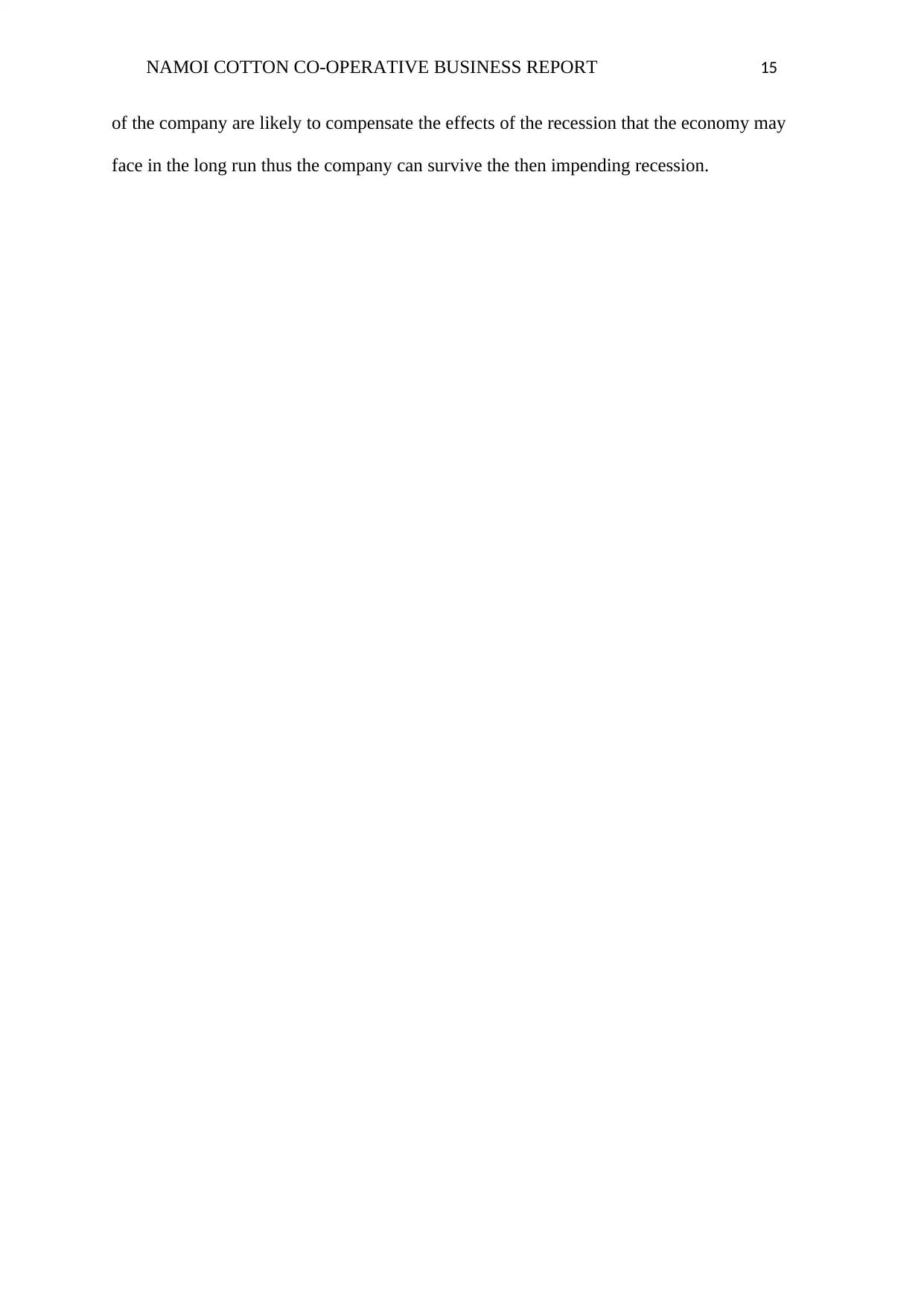
NAMOI COTTON CO-OPERATIVE BUSINESS REPORT 15
of the company are likely to compensate the effects of the recession that the economy may
face in the long run thus the company can survive the then impending recession.
of the company are likely to compensate the effects of the recession that the economy may
face in the long run thus the company can survive the then impending recession.
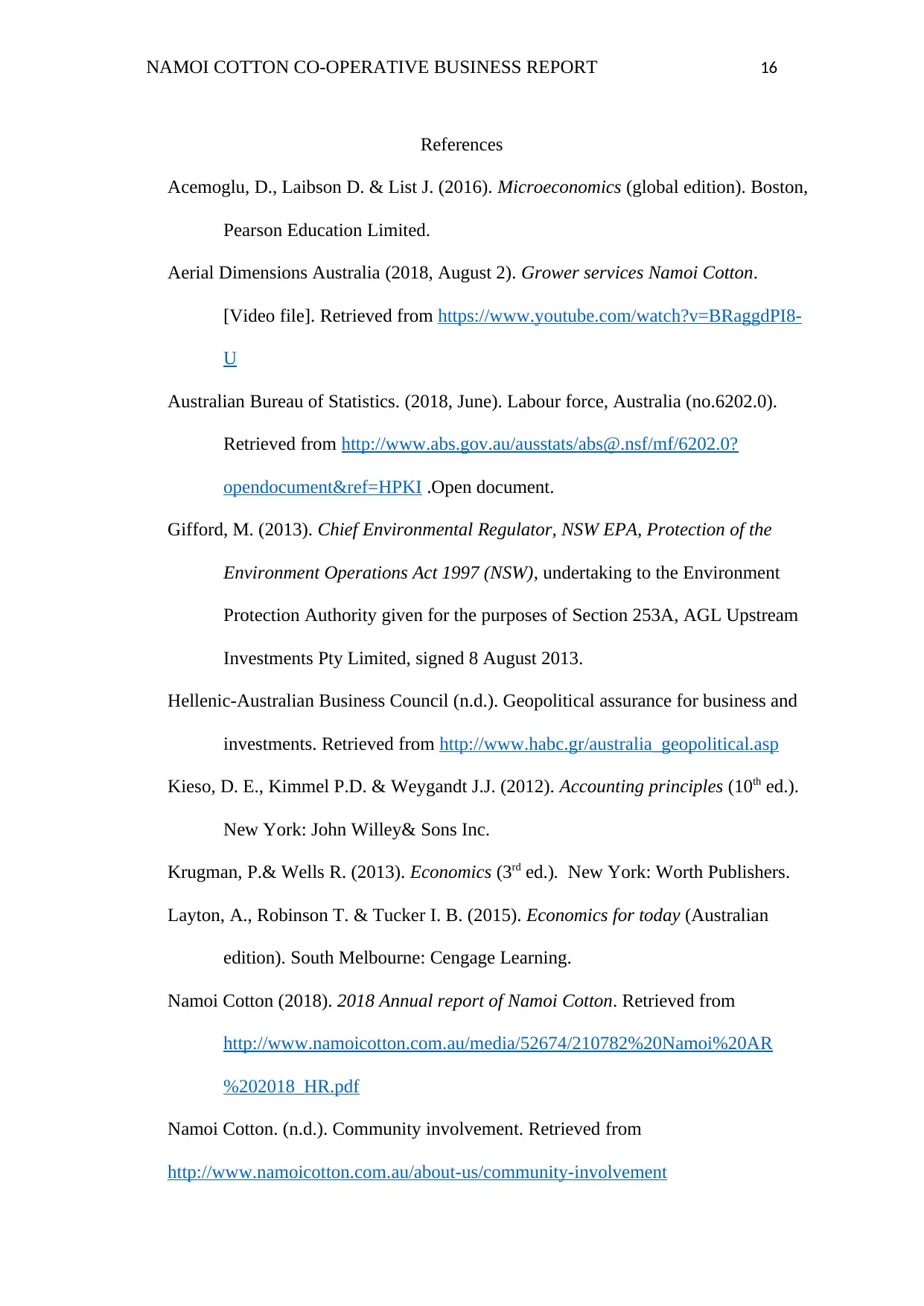
NAMOI COTTON CO-OPERATIVE BUSINESS REPORT 16
References
Acemoglu, D., Laibson D. & List J. (2016). Microeconomics (global edition). Boston,
Pearson Education Limited.
Aerial Dimensions Australia (2018, August 2). Grower services Namoi Cotton.
[Video file]. Retrieved from https://www.youtube.com/watch?v=BRaggdPI8-
U
Australian Bureau of Statistics. (2018, June). Labour force, Australia (no.6202.0).
Retrieved from http://www.abs.gov.au/ausstats/abs@.nsf/mf/6202.0?
opendocument&ref=HPKI .Open document.
Gifford, M. (2013). Chief Environmental Regulator, NSW EPA, Protection of the
Environment Operations Act 1997 (NSW), undertaking to the Environment
Protection Authority given for the purposes of Section 253A, AGL Upstream
Investments Pty Limited, signed 8 August 2013.
Hellenic-Australian Business Council (n.d.). Geopolitical assurance for business and
investments. Retrieved from http://www.habc.gr/australia_geopolitical.asp
Kieso, D. E., Kimmel P.D. & Weygandt J.J. (2012). Accounting principles (10th ed.).
New York: John Willey& Sons Inc.
Krugman, P.& Wells R. (2013). Economics (3rd ed.). New York: Worth Publishers.
Layton, A., Robinson T. & Tucker I. B. (2015). Economics for today (Australian
edition). South Melbourne: Cengage Learning.
Namoi Cotton (2018). 2018 Annual report of Namoi Cotton. Retrieved from
http://www.namoicotton.com.au/media/52674/210782%20Namoi%20AR
%202018_HR.pdf
Namoi Cotton. (n.d.). Community involvement. Retrieved from
http://www.namoicotton.com.au/about-us/community-involvement
References
Acemoglu, D., Laibson D. & List J. (2016). Microeconomics (global edition). Boston,
Pearson Education Limited.
Aerial Dimensions Australia (2018, August 2). Grower services Namoi Cotton.
[Video file]. Retrieved from https://www.youtube.com/watch?v=BRaggdPI8-
U
Australian Bureau of Statistics. (2018, June). Labour force, Australia (no.6202.0).
Retrieved from http://www.abs.gov.au/ausstats/abs@.nsf/mf/6202.0?
opendocument&ref=HPKI .Open document.
Gifford, M. (2013). Chief Environmental Regulator, NSW EPA, Protection of the
Environment Operations Act 1997 (NSW), undertaking to the Environment
Protection Authority given for the purposes of Section 253A, AGL Upstream
Investments Pty Limited, signed 8 August 2013.
Hellenic-Australian Business Council (n.d.). Geopolitical assurance for business and
investments. Retrieved from http://www.habc.gr/australia_geopolitical.asp
Kieso, D. E., Kimmel P.D. & Weygandt J.J. (2012). Accounting principles (10th ed.).
New York: John Willey& Sons Inc.
Krugman, P.& Wells R. (2013). Economics (3rd ed.). New York: Worth Publishers.
Layton, A., Robinson T. & Tucker I. B. (2015). Economics for today (Australian
edition). South Melbourne: Cengage Learning.
Namoi Cotton (2018). 2018 Annual report of Namoi Cotton. Retrieved from
http://www.namoicotton.com.au/media/52674/210782%20Namoi%20AR
%202018_HR.pdf
Namoi Cotton. (n.d.). Community involvement. Retrieved from
http://www.namoicotton.com.au/about-us/community-involvement
Secure Best Marks with AI Grader
Need help grading? Try our AI Grader for instant feedback on your assignments.
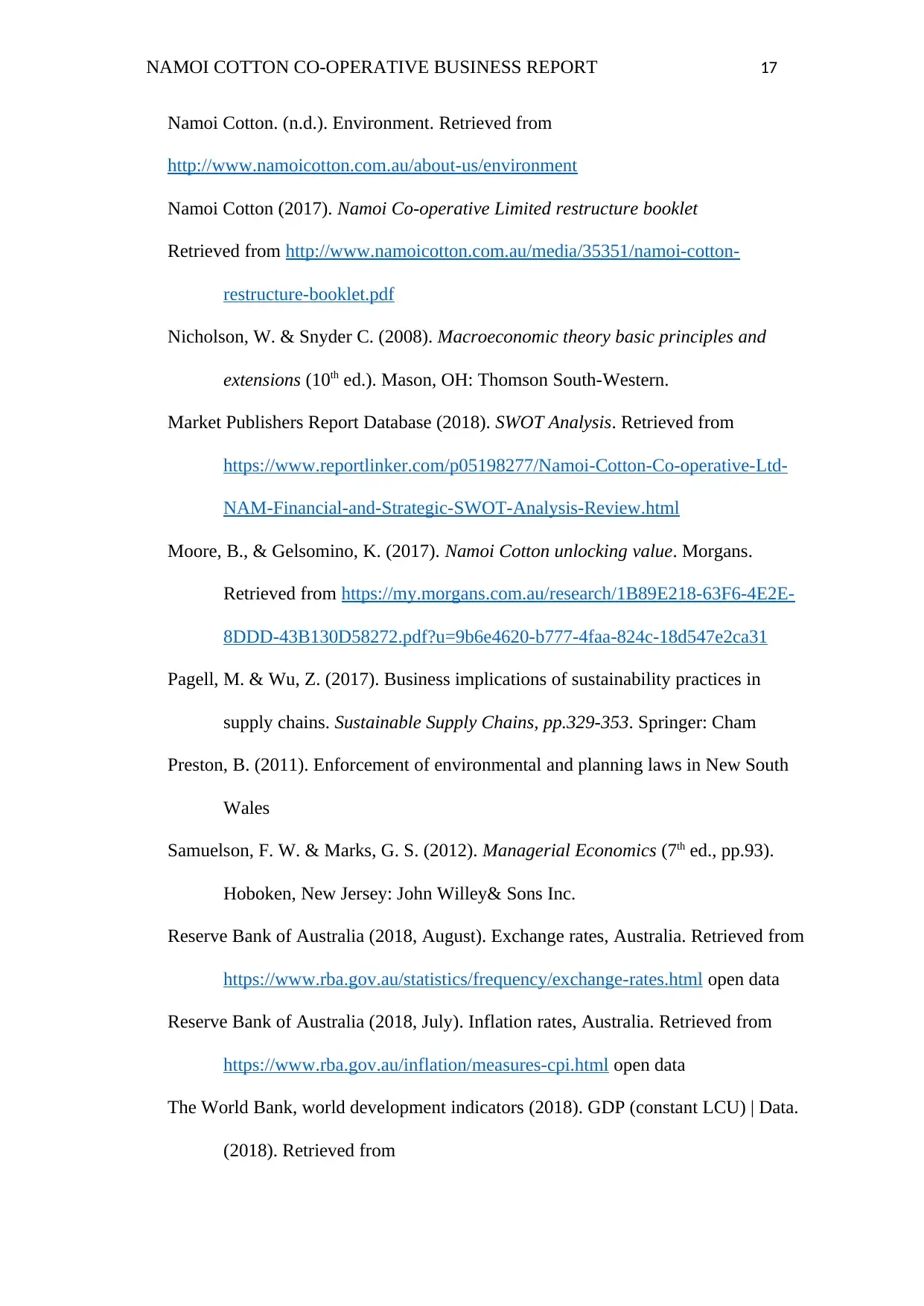
NAMOI COTTON CO-OPERATIVE BUSINESS REPORT 17
Namoi Cotton. (n.d.). Environment. Retrieved from
http://www.namoicotton.com.au/about-us/environment
Namoi Cotton (2017). Namoi Co-operative Limited restructure booklet
Retrieved from http://www.namoicotton.com.au/media/35351/namoi-cotton-
restructure-booklet.pdf
Nicholson, W. & Snyder C. (2008). Macroeconomic theory basic principles and
extensions (10th ed.). Mason, OH: Thomson South-Western.
Market Publishers Report Database (2018). SWOT Analysis. Retrieved from
https://www.reportlinker.com/p05198277/Namoi-Cotton-Co-operative-Ltd-
NAM-Financial-and-Strategic-SWOT-Analysis-Review.html
Moore, B., & Gelsomino, K. (2017). Namoi Cotton unlocking value. Morgans.
Retrieved from https://my.morgans.com.au/research/1B89E218-63F6-4E2E-
8DDD-43B130D58272.pdf?u=9b6e4620-b777-4faa-824c-18d547e2ca31
Pagell, M. & Wu, Z. (2017). Business implications of sustainability practices in
supply chains. Sustainable Supply Chains, pp.329-353. Springer: Cham
Preston, B. (2011). Enforcement of environmental and planning laws in New South
Wales
Samuelson, F. W. & Marks, G. S. (2012). Managerial Economics (7th ed., pp.93).
Hoboken, New Jersey: John Willey& Sons Inc.
Reserve Bank of Australia (2018, August). Exchange rates, Australia. Retrieved from
https://www.rba.gov.au/statistics/frequency/exchange-rates.html open data
Reserve Bank of Australia (2018, July). Inflation rates, Australia. Retrieved from
https://www.rba.gov.au/inflation/measures-cpi.html open data
The World Bank, world development indicators (2018). GDP (constant LCU) | Data.
(2018). Retrieved from
Namoi Cotton. (n.d.). Environment. Retrieved from
http://www.namoicotton.com.au/about-us/environment
Namoi Cotton (2017). Namoi Co-operative Limited restructure booklet
Retrieved from http://www.namoicotton.com.au/media/35351/namoi-cotton-
restructure-booklet.pdf
Nicholson, W. & Snyder C. (2008). Macroeconomic theory basic principles and
extensions (10th ed.). Mason, OH: Thomson South-Western.
Market Publishers Report Database (2018). SWOT Analysis. Retrieved from
https://www.reportlinker.com/p05198277/Namoi-Cotton-Co-operative-Ltd-
NAM-Financial-and-Strategic-SWOT-Analysis-Review.html
Moore, B., & Gelsomino, K. (2017). Namoi Cotton unlocking value. Morgans.
Retrieved from https://my.morgans.com.au/research/1B89E218-63F6-4E2E-
8DDD-43B130D58272.pdf?u=9b6e4620-b777-4faa-824c-18d547e2ca31
Pagell, M. & Wu, Z. (2017). Business implications of sustainability practices in
supply chains. Sustainable Supply Chains, pp.329-353. Springer: Cham
Preston, B. (2011). Enforcement of environmental and planning laws in New South
Wales
Samuelson, F. W. & Marks, G. S. (2012). Managerial Economics (7th ed., pp.93).
Hoboken, New Jersey: John Willey& Sons Inc.
Reserve Bank of Australia (2018, August). Exchange rates, Australia. Retrieved from
https://www.rba.gov.au/statistics/frequency/exchange-rates.html open data
Reserve Bank of Australia (2018, July). Inflation rates, Australia. Retrieved from
https://www.rba.gov.au/inflation/measures-cpi.html open data
The World Bank, world development indicators (2018). GDP (constant LCU) | Data.
(2018). Retrieved from
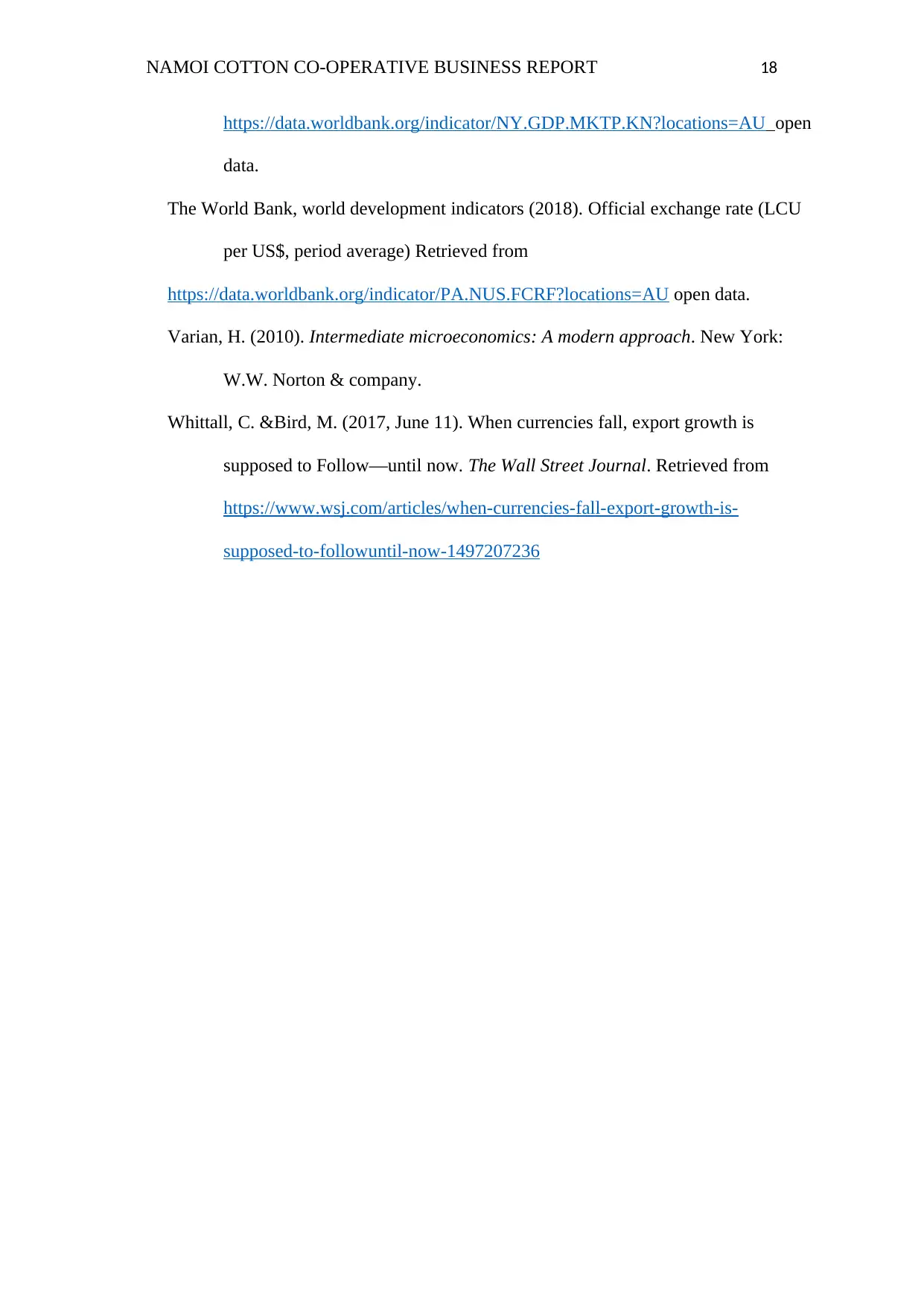
NAMOI COTTON CO-OPERATIVE BUSINESS REPORT 18
https://data.worldbank.org/indicator/NY.GDP.MKTP.KN?locations=AU open
data.
The World Bank, world development indicators (2018). Official exchange rate (LCU
per US$, period average) Retrieved from
https://data.worldbank.org/indicator/PA.NUS.FCRF?locations=AU open data.
Varian, H. (2010). Intermediate microeconomics: A modern approach. New York:
W.W. Norton & company.
Whittall, C. &Bird, M. (2017, June 11). When currencies fall, export growth is
supposed to Follow—until now. The Wall Street Journal. Retrieved from
https://www.wsj.com/articles/when-currencies-fall-export-growth-is-
supposed-to-followuntil-now-1497207236
https://data.worldbank.org/indicator/NY.GDP.MKTP.KN?locations=AU open
data.
The World Bank, world development indicators (2018). Official exchange rate (LCU
per US$, period average) Retrieved from
https://data.worldbank.org/indicator/PA.NUS.FCRF?locations=AU open data.
Varian, H. (2010). Intermediate microeconomics: A modern approach. New York:
W.W. Norton & company.
Whittall, C. &Bird, M. (2017, June 11). When currencies fall, export growth is
supposed to Follow—until now. The Wall Street Journal. Retrieved from
https://www.wsj.com/articles/when-currencies-fall-export-growth-is-
supposed-to-followuntil-now-1497207236
1 out of 18
Related Documents
Your All-in-One AI-Powered Toolkit for Academic Success.
+13062052269
info@desklib.com
Available 24*7 on WhatsApp / Email
![[object Object]](/_next/static/media/star-bottom.7253800d.svg)
Unlock your academic potential
© 2024 | Zucol Services PVT LTD | All rights reserved.





